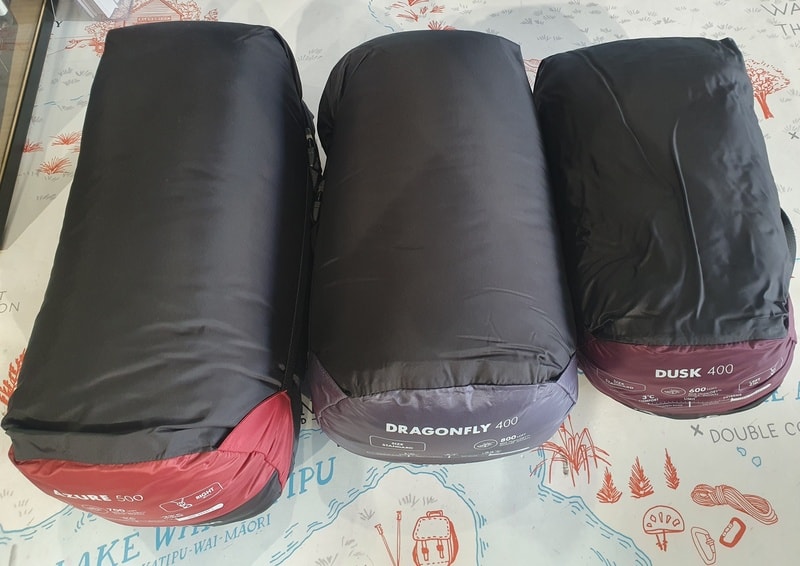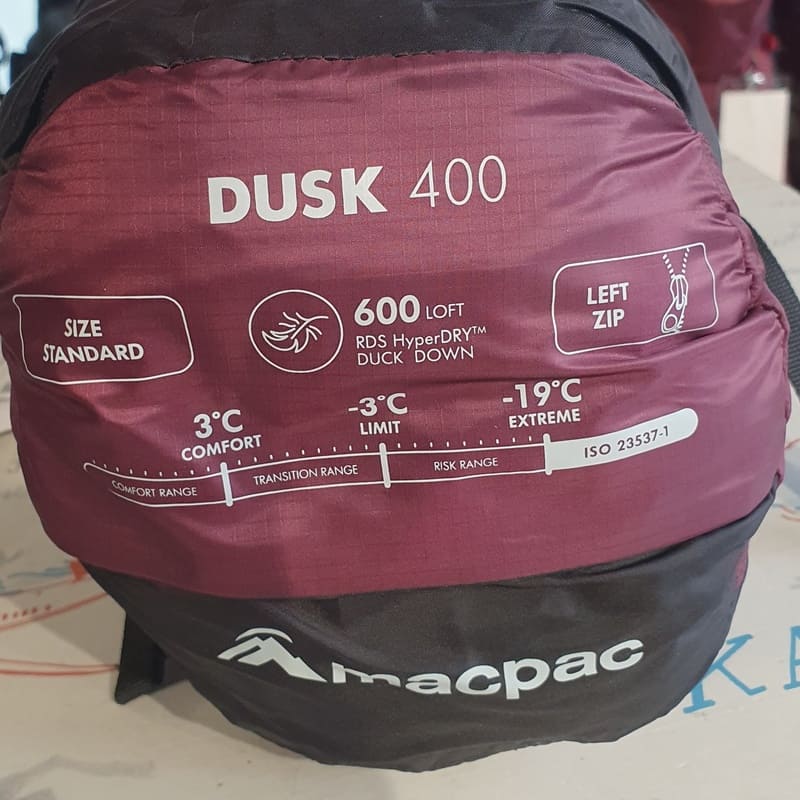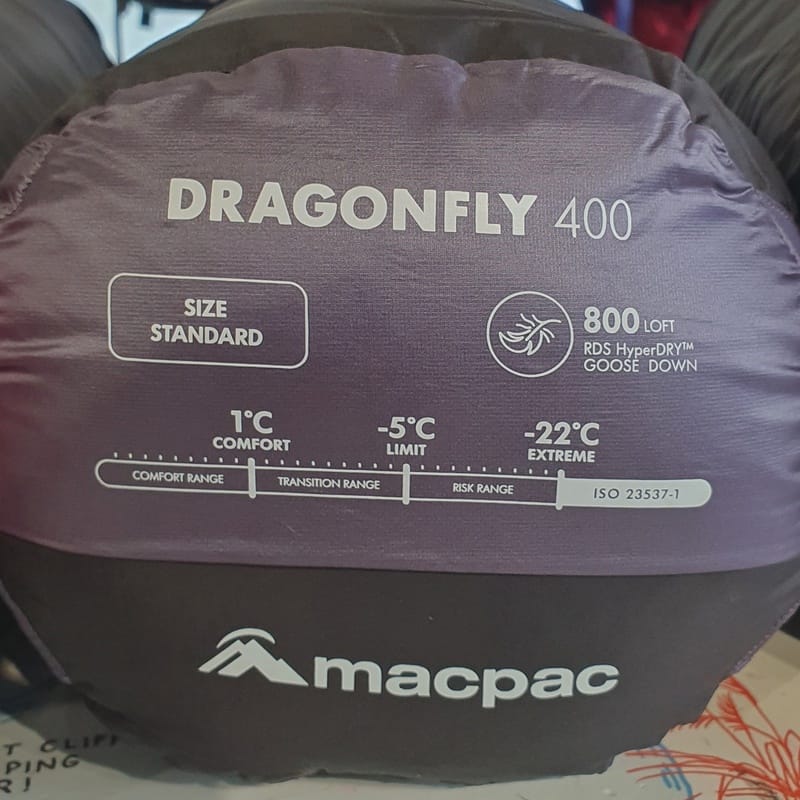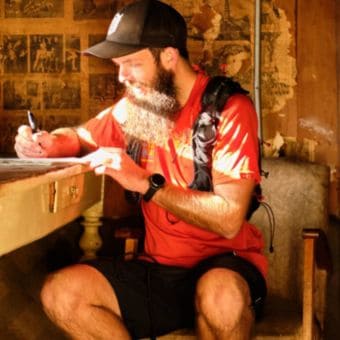Buying a new sleeping bag for New Zealand can be overwhelming. By the time you factor in price, brand, and weight, there’s already so much information before diving into the finer details.
While there are lots of sleeping bag brands to consider, this post is going to focus on Macpac sleeping bags only. I work for Macpac on the shop floor so feel like I have enough experience with them to be able to help.
For what it’s worth, the Dusk 400 is the most popular sleeping bag sold at Macpac. It’s suitable for most people who are looking to stay in huts, or go camping during the warmer months of the year.
You can buy it online here in NZ, or online here in Australia.
In this post we’ll cover the following (you can click the links to jump straight to that section):
Note: What I am NOT going to talk about are the Macpac sleeping bags for kids and quilts. If you’re considering these and have any questions, feel free to send me an email at jub@churnewzealand.com and I’m happy to give you my two cents.
1. AN OVERVIEW OF THE MACPAC SLEEPING BAGS

To start, here’s a comparison table of the various sleeping bags from Macpac. For simplicity, the information about down fill and synthetic fill sleeping bags are on separate tables.
Note: All of Macpac sleeping bags are bluesign certified. All down filled bags use RDS Certified down, and all synthetic bags use recycled polyester.
DOWN SLEEPING BAGS FROM MACPAC
| AZURE 500 W | 0 | -6 | -23 | 1090 | Relaxed Mummy |
| AZURE 500 STD | 0 | -6 | -23 | 1097 | Relaxed Mummy |
| AZURE 500 LGE | 0 | -6 | -23 | 1121 | Relaxed Mummy |
| AZURE 700 W | -4 | -11 | -30 | 1332 | Relaxed Mummy |
| AZURE 700 STD | -4 | -11 | -30 | 1345 | Relaxed Mummy |
| AZURE 700 LGE | -4 | -11 | -30 | 1454 | Relaxed Mummy |
| DRAGONFLY 400 STD | 1 | -5 | -22 | 731 | Mummy |
| DRAGONFLY 400 LGE | 1 | -5 | -22 | 781 | Mummy |
| DRAGONFLY 600 STD | -3 | -10 | -29 | 981 | Mummy |
| DRAGONFLY 600 LGE | -3 | -10 | -29 | 1064 | Mummy |
| DUSK 400 W | 3 | -3 | -19 | 898 | Relaxed Mummy |
| DUSK 400 STD | 3 | -3 | -19 | 917 | Relaxed Mummy |
| DUSK 400 LGE | 3 | -3 | -19 | 1004 | Relaxed Mummy |
| ESCAPADE 150 | 20 | 17 | 9 | 526 | Semi-Rectangular |
| ESCAPADE 350 STD | 4 | -2 | -18 | 996 | Semi-Rectangular |
| ESCAPADE 350 XL | 4 | -2 | -18 | 1060 | Semi-Rectangular |
| ESCAPADE 500 W | -1 | -7 | -25 | 1101 | Semi-Rectangular |
| ESCAPADE 500 STD | -1 | -7 | -25 | 1111 | Semi-Rectangular |
| ESCAPADE 500 XL | -1 | -7 | -25 | 1250 | Semi-Rectangular |
| ESCAPADE 700 W | -3 | -10 | -29 | 1312 | Semi-Rectangular |
| ESCAPADE 700 STD | -3 | -10 | -29 | 1322 | Semi-Rectangular |
| ESCAPADE 700 XL | -3 | -10 | -29 | 1460 | Semi-Rectangular |
| FIREFLY 200 STD | 7 | 3 | -11 | 467 | Mummy |
| FIREFLY 200 LGE | 7 | 3 | -11 | 506 | Mummy |
| SERAC STD | -10 | -17 | -40 | 1469 | Mummy |
| SERAC LGE | -10 | -17 | -40 | 1615 | Mummy |
SYNTHETIC SLEEPING BAGS FROM MACPAC
| ASPIRE 360 LGE | -3 | -10 | -29 | 1891 | Relaxed Mummy |
| ASPIRE 360 STD | -3 | -10 | -29 | 1705 | Relaxed Mummy |
| ROAM 200 LGE | 5 | -1 | -16 | 1933 | Rectangular |
| ROAM 200 STD | 5 | -1 | -16 | 1742 | Rectangular |
2. SLEEPING BAG FAQs
Do I need a large, standard, or women sleeping bag?
For most people, including women, a standard sleeping bag will do the trick. Macpac is standardizing its sleeping bag sizes to make it easy to know which one to choose.
In general for optimal warmth, Macpac suggests the maximum user height is 25cm less than the stated length of the sleeping bag.
You can see the
Does the shape of the sleeping bag matter?
Most people who come in to look at sleeping bags at Macpac aren’t concerned about the different shapes. But if you’re looking for optimal performance, it’s something to consider. Macpac has a few different shapes:
- Rectangular: As it says, they’re more rectangular at the shoulders and at the foot box. So they’re roomier, and can be unzipped to act as a quilt.
- Relaxed Mummy: The go to shape for most hikers as they’re narrower at the shoulders and hips before tapering towards the foot box. Less roomy, but better than the rectangular shaped bags for optimal warmth.
- Mummy: Narrower than a relaxed mummy fit, this shape has the best warmth-to-weight ratio. You’ll only find this shape on the Firefly, Serac, and Dragonfly.
What do the comfort ratings mean?
The temperature ratings on a sleeping bag can be confusing. Some people are warm sleepers and others are cold. But the Macpac sleeping bags are all tested against ISO 23537-1 standard which will help you compare the sleeping bags against those of other competitors (if a sleeping bag isn’t tested against this standard, it’s hard to know exactly how warm it’ll be).
Without going into too much jargon, the three definitions are:
- Comfort: This is at the lower limit of the comfort range. It’s the temperature that an average female can lay on their back in a relaxed posture and be at thermal equilibrium. If he temperature dropped below this, they’d start to feel the cold.
- Limit: The lower limit where an average male will be at thermal equilibrium when in a curled-up body position.
- Extreme: Hopefully you won’t be in this situation, but this is the temperature where hypothermia can start to be an issue after 6+ hours (although frostbite could still occur).
I like this short Wikipedia page
Other than Macpac sleeping bags, what other options are there in New Zealand?
There are a whole host of brands available in New Zealand. Some of the more popular options you’ll see in huts around the country include, but are not limited to:
- Kathmandu
- Sea to Summit
- Exped
- Rab
- Mont
Should I get a down or synthetic sleeping bag?
The best Macpac sleeping bag for most people is going to be down (Macpac has bags with duck and goose down). But down is a lot more expensive than synthetic. Here’s a list of the benefits of each insulation type:
Synthetic
- More affordable than down
- Insulates when wet
- Dries fast
- Non-allergenic
Down
- Lightweight
- Keeps you warm in cold, dry weather
- Packable, much more so than down
- Durable. You can keep a down sleeping bag for years (people will have there’s for 20+ years)
- Some of the Macpac sleeping bags are made with hyper dry down which can help in damp conditions
Does LHZ or RHZ matter?
This means your sleeping bag has Left-Hand Zipper (on the left-hand side of the sleeping bag) and a Right Hand Zipper.
If you’re a right-handed, you should get an LHZ if possible as it’s easiest to operate. But in fairness, it’s a minor detail.
3. MORE DETAILS ABOUT THE MACPAC SLEEPING BAGS
THE DUSK 400

This is the best Macpac sleeping bag for most people and is the most popular sleeping bag I sell at Macpac. For someone who wants a down sleeping bag to ensure they’ll be warm for their summer missions, it’s one of more affordable options.
It’s a solid bag, with a comfort level that’s going to be good for those who are staying at huts most of the time (3 seasons), with some tent camping in the summer. It’s pretty light and packs down a charm.
The sleeping bag packs in 410g of 600 loft HyperDRY™ RDS duck down. I’m always amazed by how tight you can pack it down. This is a practical relaxed mummy bag that can attach to sleeping mats, and it has a phone pocket which is helpful in the cold to stop your battery from draining. If you have a LHZ Dusk and a RHZ Dusk, you can zip them together to create a quilt.
FEATURES
- Available in standard and large
- Fill Type: 90/10 HyperDRY™ RDS Duck Down
- Main Fabric: 100% Recycled Nylon Ripstop (20D) — bluesign® certified
- Temperature Rating: Comfort 3°C / Limit -3°C / Extreme -19°C
- Packed Dimensions: 32 x 20 x 18cm
- Weight: 917g (standard)
FIREFLY 200
This is a super lightweight summer sleeping bag that suits the likes of those on the Te Araroa (or other thru-hikers), bike packers, fast packers, and adventurers where weight matters.
Given it’s made from goose down, this is not a cheap sleeping bag. It’s the same price as the Dusk 400, but most people don’t mind the extra bit of weight and to have a warmer, more functional bag (the Firefly 200 is zipperless as zips increase weight).
The fact that the bag has no zips is a turn-off for a lot of people, as the top is wider, but can be cinched in tight.
Holding the Firefly feels like you’re holding a small Halo Jacket in its stuff sack, it’s that small and the standard does weigh just 467 grams. But the 200g of 800 loft HyperDRY™ RDS goose down will keep you warm (the mummy fit helps).
FEATURES
- Available in standard and large
- Fill Type: Water resistant 90/10 HyperDRY™ RDS Goose Down
- Temperature Rating: Comfort 7°C / Limit 3°C / Extreme -11°C
- Packed dimensions: 25 x 14 x 13cm
- Main Fabric: Pertex® Quantum 100% Recycled Nylon (15D)
- Weight: 467 grams (standard)
AZURE RANGE

The Azure range is a flexible bag, with the Azure 500 great for the warmer end of three-season use, and the 700 can deal with colder weather across three seasons when camping.
These sleeping bags feature box baffles for plenty of warmth, but if you do find yourself getting warm then you can undo the zips on each side for ventilation. I like the feature where the zip isn’t at the bottom of the bag so your toes can stay as warm as possible, but you can still undo the bottom and hook the bottom of the bag to walk around with your bag wrapped around you.
And yes, two Azures can be zipped together to create a quilt. They also feature a phone pocket to prevent the cold from draining your battery (crazy how annoying this is right?).
AZURE 500 FEATURES
- Available in standard and large
- Fill Type: 90/10 HyperDRY™ RDS Duck Down
- Temperature Rating: Comfort 0°C / Limit -6°C / Extreme -23°C
- Packed Dimensions: 35 x 20 x 19cm
- Weight: 1,097g
- Main Fabric: 100% Recycled Nylon Ripstop (20D) — bluesign® certified
AZURE 700 FEATURES
- Available in standard and large
- Fill Type: 90/10 HyperDRY™ RDS Duck Down
- Temperature Rating: Comfort -4°C / Limit -11°C / Extreme -30°C
- Packed Dimensions: 38 x 22 x 20cm
- Weight: 1,345g
- Main Fabric: 100% Recycled Nylon Ripstop (20D) — bluesign® certified
DRAGONFLY RANGE

With the Dragonfly series featuring goose down, the 400 makes for an awesome weekend where you don’t need to think about most things other than go and you’ll be warm. But if there’s going to be colder temperatures, the Dragonfly 600 is going to be the option for you with its -4°C comfort rating.
The Pertex® Quantum outer might look delicate, but with the Y Fuse tech they use in the bag, it’s great for both performance and durability, especially around snow.
The box baffles ensure cold spots aren’t a big issue and you can adjust the hood to comfort. The zip runs one-third of the way down the bag, balancing the function of the bag with the weight.
This sleeping bag can be compressed really small if you use a Sea to Summit compression sack!
DRAGONFLY 400 FEATURES
- Available in standard and large
- Packed Dimensions: 30 x 20 x 18cm
- Weight: 731g
- Fill Type: 90/10 HyperDRY™ RDS Goose Down
- Main Fabric: Pertex® Quantum 100% Recycled Nylon (15D)
- Packed Dimensions: 30 x 20 x 18cm
DRAGONFLY 600 FEATURES
- Available in standard and large
- Fill Type: 90/10 HyperDRY™ RDS Goose Down
- Main Fabric: Pertex® Quantum 100% Recycled Nylon (15D)
- Temperature Rating: Comfort -3°C / Limit -10°C / Extreme -29°C
- Weight: 981g
- Packed Dimesions: 36 x 20 x 18cm
SERAC 1000
Camping above the snowline? You’ll probably want something like the Serac in your arsenal.
Anyone who is looking at Macpac sleeping bags and mentions the Serac instantly gets brownie points. This is the flagship alpine bag from Macpac and is great for those alpine/super cold regions.
It has HyperDRY Goose Down as you’d expect, and with 1000g of goose in the bag so it’s toasty! The box baffles and outer use all of the optimal formats to ensure high performance.
You know this is a serious bag when there’s a half zip at the foot box so you could warm it up further if need be!
It’s fair to say, if you’re considering this bag already, you can probably disregard reading the rest of the post as you’ll have plenty of knowledge already.
FEATURES
- Available in standard and large
- Fill Type: 90/10 HyperDRY™ RDS Goose Down
- Main Fabric: Pertex® Quantum 100% Recycled Nylon (15D)
- Packed Dimensions: 43 x 25 x 23cm
- Weight: 1,469g
- Temperature Rating: Comfort -10°C / Limit -17°C / Extreme -40°C
ESCAPADE RANGE
There are four sleeping bags in the Escapade series, 150, 350, 500, and 700.
The Escapade 150 is a super lightweight bag that can be a light cover in hot climates or act as a liner to warm up your other bag (the built-in stuff stack is handy). The zip is full length so it can be used as a quilt. Given this bag is so lightweight, it’s not a very popular bag in terms of sales.
The 350, 500, and 700 all have similar traits, other than the amount of duck down in each of the trapezoid baffles in each bag. They all feature a full-length side zip and you can walk around in the sleeping bag thanks to the foot box zip. Or convert them into a duvet or zip the together with another bag.
The soft dome closures are always a good feature, as is the zip pocket on the inside to prevent your battery from draining.
ESCAPDE 150 FEATURES
- Available in standard and large
- Fill Type: 80/20 RDS Duck Down
- Temperature Rating: Comfort 20°C / Limit 17°C / Extreme 9°C
- Packed Dimensions: 21 x 13cm
- Weight: 526g
- Main Fabric: Pertex® Quantum 100% Nylon
ESCAPDE 350 FEATURES
- Available in standard and large
- Fill Type: 80/20 RDS Duck Down
- Temperature Rating: Comfort 4°C / Limit -2°C / Extreme -18°C
- Packed Dimensions: 31 x 17cm
- Weight: 996g
- Main Fabric: Pertex® Quantum 100% Nylon
ESCAPADE 500 FEATURES
- Available in women, standard and large
- Fill Type: 80/20 RDS Duck Down
- Temperature Rating: Comfort -1°C / Limit -7°C / Extreme -25°C
- Packed Dimensions: 35 x 20cm
- Weight: 1,111g
- Main Fabric: Pertex® Quantum 100% Nylon
ESCAPADE 700 FEATURES
- Available in women, standard and large
- Fill Type: 80/20 RDS Duck Down
- Temperature Rating: Comfort -3°C / Limit -10°C / Extreme -29°C
- Packed Dimensions: 36 x 22cm
- Weight: 1,322g
- Main Fabric: Pertex® Quantum 100% Nylon
ASPIRE 360
This is a super warm synthetic bag that’s made for all kinds of camping. The two layers of recycled polyester insulation can keep you comfortable in conditions down to -3°C, and there are the technical aspects like the relaxed mummy fit.
Other fun aspects of the bag are the internal draft tube, drawcord, and collar are all designed to keep the warmth inside the bag.
The nylon outer feels shiny, but it’s made of ripstop so is durable. The phone pocket is handy as always, and you can zip two Aspire 360 bags together for a large quilt.
FEATURES
- Available in standard and large
- Fill Type: 100% Recycled Polyester
- Temperature Rating: Comfort -3°C / Limit -10°C / Extreme -29°C
- Packed Dimensions: 43 x 26 x 23cm
- Weight: 1,705g
- Main Fabric: 100% Nylon Ripstop (20D)
ROAM 200
The rectangular Roam 200 is a rectangular bag that can be unzipped to become a quilt, ideal for flexible camping solutions.
The two layers of recycled polyester material aren’t as compactable as down, but it’ll keep you cosy with its internal draft tube and adjustable hood. The bag also has useful features like a phone pocket and a bottom zip so you can walk around with the bag.
FEATURES
- Available in standard and large
- Fill Type: 100% Recycled Polyester
- Temperature Rating: Comfort 5°C / Limit -1°C / Extreme -16°C
- Packed Dimensions: 42 x 26 x 23cm
- Weight: 1,742g
- Main Fabric: 100% Polyester (50D) — bluesign® certified
And there you go, that’s a guide to Macpac sleeping bags. It’s not an easy thing to figure out, but as I mentioned earlier, for most people the Dusk 400 is going to the best bag for most people.
If you’ve got any questions about buying a sleeping from Macpac or elsewhere, I’m happy to help answer any questions you have. Send me an email at jub@churnewzealand.com.
MORE MACPAC PRODUCT REVIEWS

Hey, it’s Jub here. I’m the guy behind Chur New Zealand, helping you have the best time hiking, trekking, walking…whatever you want to call it…in NZ. I’m based in Queenstown and am always out and about exploring trails, old & new. If you have any questions, reach out.

Hello there!
I have a Macpac Neve, about 25 yrs old now, but has been in storage for 20 yrs. in the storage bag, in a large plastic storage box, with lid. Its in great condition, only used in Tas for the overland track and great western tiers.
I’m considering using it in May 2024 to do the Annapurna base camp trek, staying in tea houses. Average low temp for March/April/May over there is -8C. The bag is 4 season, 100% goose down (but I don’t know what loft power that is), and 400g/m2 of fill. Bag weighs 1 kg. It has no down underneath the sleeper, but because we will be off the floor on mattresses, I’m not too concerned about that. I actually got extra down in mine which I think is the Neve K2, it weighs 1.2kg (I actually have two Neve’s, one was my partners at the time)
I’ve asked Macpac if there was a temperature rating but doesn’t seem to be available from back then. My plan is to wear wool thermals in bed, plus socks, and purchase the Sea to Summit Fleece liner which is meant to add 18C warmth to the sleeping system (the warmest one they sell).
Otherwise I spend big dollars on a new bag and torture a whole bunch more geese, neither of which I really want to do, if this other plan is sound.
I would love your opinion as to whether you think this might be sufficient for this trek?
(I know there’s no guarantees, but your thoughts would be very appreciated).
Thanks heaps!
Kay
Hey Kay,
Sounds like it’s been stored well so the down shouldnt be too damaged. It’s super tough to know, but I would say it’s going to be as gold based on what you’ve said.
-8 looks like worst case scenario…hopefully the tea houses have fires going? At worst, I’d say the tea houses will have a spare blanket or two for worst case scenarios? That’s my two cents, don’t hold me too it though haha.
I’ve tried looking up old ratings for Macpac sleeping bags, and it’s nigh on impossible. I’d say you go with your plan! Have fun!
Cheers, Jub